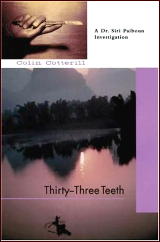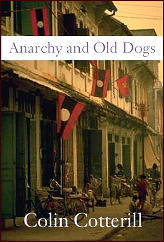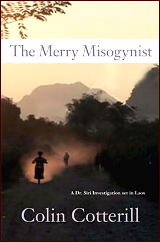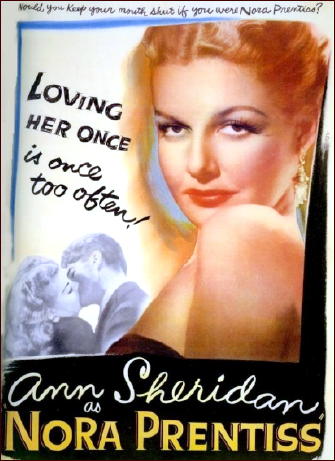April 2010
Monthly Archive
Fri 30 Apr 2010
Posted by Steve under
Reviews[31] Comments
Reviewed by DAVID L. VINEYARD:
JAMES HADLEY CHASE – I’ll Get You For This. Jarrolds, UK, hardcover, 1946. Avon Monthly Novel #18, US, digest-sized paperback, 1951. Filmed as Lucky Nick Cain, 1951, with George Raft, Coleen Gray & Walter Rilla.
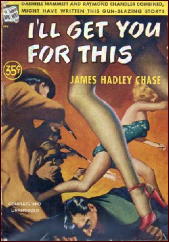
They said I was the fastest gun-thrower in the country. Maybe I was, but I didn’t tell anyone that I practised (sic) two hours a day, wet or shine. I killed guys, but it wasn’t murder. Even the cops said so, and they should know. Every time I killed a guy I made sure he had the drop on me first, and I had witnesses to prove it. I’d worked it so I could pull a gun and shoot before the other guy could squeeze his trigger.
That’s Chester Cain, the hero of James Hadley Chase’s novel I’ll Get You For This, a gambler with a fast gun that would make Mike Hammer or Race Williams blink twice and a barely legal reputation. Like pulpster Gordon Young’s Don Everhard from an earlier age, he’s a fast shooting two-fisted professional gambler who is a law unto himself.
In I’ll Get You For This Cain has just arrived in Paradise Palm, a coastal beauty spot where he hopes to spend a little vacation time after a grueling few months of profitable gambling up north. He has a bankroll, and he’s in the mood to enjoy it.
And Paradise Palm seems just the kind of place to enjoy it all. The beaches are stacked with beautiful women if various states of extreme immodesty and even the cops call him sir. In fact, people couldn’t be nicer.
The buildings were compact, red roofed with white walls. Tree-lined avenues led into the town from four directions. Flower-beds decorated the sidewalks. Every tropical flower, tree and plant grew in the streets, and the effect was like a dream in Technicolor. The colours* hurt my eyes.
After I’d stared at the flowers, I concentrated on the women, driving in big luxury cars or walking along the sidewalks, or even riding bicycles. It was as good as an Earl Carrol show. There wasn’t a woman who hadn’t stripped down to the bare essentials. My eyes hadn’t overeaten themselves like this in years.
And if they don’t give him the key to the city or roll out the red carpet, they do just about everything short of that. The owner of the local casino, Don Speratza, even calls him up personally when he checks in at the hotel, to invite him for a night of recreational gaming and offer female companionship. Then Ed Killeano, the city administrator* calls up to tell him how glad they are to have him.
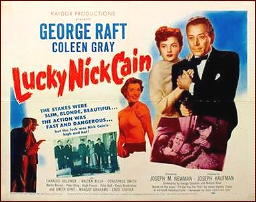
By now Cain’s a bit suspicious, but he’s willing to play along and see where all this is going. The only man who acts at all normal is John Herrick, a reform candidate who isn’t excited about trouble like Cain showing up in town.
But Cain doesn’t have long to worry about that when he is introduced to Miss Wonderly:
A girl came across the room towards us. She was wearing a bolero for a dinner jacket of blue crepe. Her skirt, split eight inches up the side, was of blue crepe, too, but her blouse was red. She was a blonde, and I bet every time she passed a graveyard the corpses sat up to whistle after her.
By the time I’d recovered my breath, she was standing at my side. Her perfume was Essence Imperiale Russe (the perfume that quickened the pulse of kings). I can’t begin to describe what it did to my pulse.
Speratza was looking at me anxiously. “Miss Wonderly,” he said, and raised his eyebrows…
Out of the corner of my eye I saw Speratza go off, and then I gave the whole of my attention to Miss Wonderly. I thought she was terrific. I liked the long wave of her hair, and her curves — particularly her curves. Her breasts were like Cuban pineapples.
“This calls for a drink,” I said, beckoning to the barman. “What part of Paradise did you escape from?”
“I didn’t escape,” she said, laughing, “I’m out on parole…”
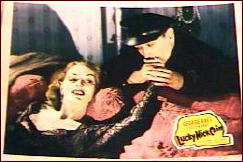
That mention of the perfume brand may have been picked up from Peter Cheyney, whose heroes seemed to be hypnotized by the Narcisse Noir his femme fatales always wore. Later James Bond did this sort of brand name thing with a bit more style and flair, Fleming borrowing some of the Americanized elements of Cheyney and Chase for the Bond saga.
But paradise doesn’t remain paradise very long and it is only the next day when a hungover Cain finds himself in a place more familiar to him:
“Who’s this guy?” the man in the gabardine suit asked, turning to the reception clerk, and pointing at me.
The reception clerk looked like he was going to throw up. His face was pale green.
“Mr. Chester Cain,” he said, in a far-away voice.
That seemed to give the ugly guy a buzz.
“Sure?” The reception clerk nodded.
The guy faced me. His flat puss was loaded with viciousness.
“We know all about you,” he said. “I’m Flaggerty of the Homicide Bureau. You’re in a hell of a jam, Cain.”
I knew I had to talk if it killed me.
“You’re crazy,” I said. “I didn’t do it.”
“When I find a rat with your reputation locked in with a murdered man I don’t have to look all that far to find his killer,” Flaggerty sneered. “You’re under arrest, and you’d better start talking.”
I tried to think, but my mind wasn’t working. I felt like hell, and my head throbbed and pounded.
It looks bad, especially since the dead man in question is Herrick — the one man in town who hadn’t offered Cain a glad hand and the key to the city. Killeano, the city administrator offers to help, but somehow Cain doesn’t trust him or his motives. Luckily for Cain they didn’t count on Clair Wonderly falling for him — she refuses to play the game even when the cops get rough.
“He didn’t do it,” she said. “It was a frame-up. I don’t care what you do to me. He didn’t do it! Do you hear? He didn’t do it!”
Killeano looked at her as if he couldn’t believe his ears. His fat face went yellow with rage. “You bitch!” he said, and slapped her hard across her face.
And Cain lets them know he isn’t finished with them:
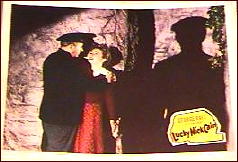
“You boys have had your fun,” I said, “and now I’m going to have mine. I came here for a vacation. All I wanted to do was to have a good time and spend my roll. But you thought you’d be smart. You wanted to murder Herrick because he was in your way. You picked me for the fall guy, and you nearly got away with it. If you hadn’t been so dumb, you would have got away with it. You killed Herrick, but you haven’t killed me, and you’ll find I’m a lot harder to kill than Herrick. I’m going to find out why you wanted Herrick out of the way, and then I’m going to complete his job…”
Cain ends up teaming with the Feds in the form of a G-Man name Hoskiss, and he and Clair bring down Killeano and Paradise Palms and the dirty racket they are running. (Hoskiss should be a T-Man since the scheme involves counterfeiting, but I suppose we have to give Brit Chase a pass on that mistake.)
But that’s not the end of it. As the gang are awaiting trial, Cain and Clair know they are in danger and try to go to ground, but the gang goes after them, and Cain has to resort to his old skills with a gun to protect them both while he hunts down Bat Thompson, the hood who killed Herrick and is now hunting Clair and him.
I caught a glimpse of Bat as he moved, lifted my gun, fired. He must have seen my movement for he fired at the same time. His bullet ploughed a weal along my cheek. I watched him. He rose up, tottered back, his gun slipping out of his hand. I fired again. The slug socked into him, throwing him back. He fell down, stretched out.
I pulled out my electric torch*. The beam lit up a nightmare scene. The girl lay on her side, bent back, half her face was shattered by the heavy bullet from Bat’s gun. Bat lay near her, his hand touched her naked foot. Blood seeped out of him like water from over-boiled cabbage I turned him over. He moved, blinked his eyes, snarled at me.
“So long, Bat,” I said, put the gun to his ear.
And Cain goes home to Clair confident that their reign of fear has ended:
The future, I decided, as I set off in the darkness, could take care of itself.
I’ll Get You For This is mid-level Chase, violent and derivative, but compulsively readable and entertaining. Chase still has a following, with many of his books available as free e-books from various sources and his numerous books collectable. He even had his champions in George Orwell, who wrote about him in his famous article “Miss Blandish and Raffles,” and Chase’s friend Graham Greene, who included one of his works in a famous anthology of thrillers.
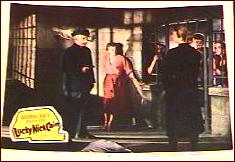
This despite the fact that Chase was twice accused of plagiarism — notably for his debut No Orchids For Miss Blandish, that sailed a bit too close to William Faulkner’s novel Sanctuary, and later having to apologize to Raymond Chandler for lifting whole passages from one of his books.
But then as Chase is recreating an entire world that existed only in books and films for him he may be forgiven if he sometimes recreated that world too closely.
That said, even in this one you know he lifted the name Wonderly from The Maltese Falcon. It was just a habit he couldn’t — or wouldn’t bother to — break.
Chase only visited the United States twice, but in general made good use of maps and a dictionary of slang in recreating a sort of fractured version of the hardboiled country of James M. Cain, Hammett, and Chandler. His work lacks the surrealism of Peter Cheyney’s Lemme Caution tales, despite which — or maybe because of which — Chase is great fun to read.
His best works sometimes read like a pastiche of a Gold Medal original or noir film.
His novels were great favorites (along with Peter Cheyney) in the famous French serie noir paperback series, and truthfully both he and Cheyney’s fractured Americanisms translated to French are a unique reading experience. Like Jerry Lewis, something may be lost in the translation back into English.
Chase wrote under several names, but other than Chase, was probably best known as Raymond Marshall.
For the most part his plots are clever if not surprising. They move fast, and at their best manage to recreate the kind of doomed noirish atmosphere of the James M. Cain book that first inspired him (The Postman Always Rings Twice) without achieving a single moment of authenticity.
In some ways you could call them the British crime equivalent of spaghetti westerns, the pulp formula boiled down to its purest elements by an eye that experienced it only through books and films.
I’ll Get You For This was made into a forgettable but mildly entertaining film, Lucky Nick Cain, with George Raft and filmed in Italy. It was relatively faithful to the basics of Chase’s plot, and was one of Raft’s better fifties outings.
___
(*) Careful readers will notice certain Anglicisms like city administrator instead of city manager or supervisor or electric torch for flashlight, and colours for colors creep in.
Previously reviewed on this blog:
No Orchids for Miss Blandish, by Bill Crider (1001 Midnights).
Hit and Run, by Steve Lewis.
Fri 30 Apr 2010
A TV Review by MIKE TOONEY:
“The Paragon.” An episode of The Alfred Hitchcock Hour (Season 1, Episode 20). First air date: 8 February 1963. Joan Fontaine, Gary Merrill, Virginia Vincent, Linda Leighton, Richard Carlyle. Teleplay: Alfred Hayes. Story: Rebecca West (source unknown). Director: Jack Smight.
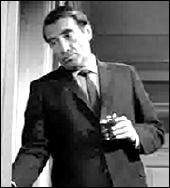
Alice Pemberton (Joan Fontaine) is one of those individuals who, wherever they go, leave discouragement in their wake. She always rubs people the wrong way and yet never seems to notice the harm she does.
From criticizing her sister’s child-rearing abilities to flicking lint off the maid’s uniform, Alice is a walking, talking affront to anyone who knows her. Her husband John (Gary Merrill) just can’t get through to her; she’s perfect and she expects everybody else to be also.
One night Alice has a dream, a nightmare really, of a dark shape floating through the bedroom window and settling over her face, smothering her. It just so happens that one of the people who know Alice well is making plans to make her dream come true ….
Joane Fontaine is best remembered for Rebecca (1940) and Suspicion (1941). She also appeared in Jane Eyre (1944), Kiss the Blood Off My Hands (1948), Born to Be Bad (1950), The Bigamist (1953), Beyond a Reasonable Doubt (1956), and Voyage to the Bottom of the Sea (1961).
We’ve already dealt with Gary Merrill’s criminous career. See “The Paragon” on Hulu here.
Thu 29 Apr 2010
Posted by Steve under
Reviews1 Comment
A REVIEW BY MARY REED:
J. S. FLETCHER – The Safety Pin. Herbert Jenkins, UK, hardcover, 1924. G. P. Putnam’s Sons, US, hc, 1924.
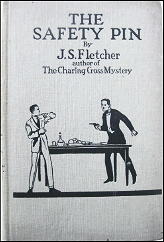
Solicitor Francis Shelmore deals only in conveyancing and lives a calm and ordered life in Southernstowe, “within sixty miles” of London.
One afternoon Miss Cynthia Pretty, youthful half-owner of a Cornish tin mine, appears in his office to ask for help in locating the mine’s co-owner James Deane, her guardian and trustee, who has disappeared from the hotel where they had arranged to meet before leaving for a trip to the continent.
Mr Deane is found murdered not far from a mansion occupied by Mrs Sophia Champernowne and her shiftless brother Alfred. She is a rich woman, mayoress of Southernstowe and owner of its biggest drapery store. Deane’s body is discovered by special constable John Hackdale, under-manager of Mrs Champernowne’s emporium and older brother of Shelmore’s shifty clerk Simmons Hackdale.
John removes The Safety Pin from Deane’s jacket and conceals its existence from those investigating the crime, not exactly the sort of behaviour most readers would expect from a special constable.
What significance can be attached to the fact that of 400 scenic postcards found in Deane’s hotel room only one has a particular house marked? Did his murderer act alone or with accomplices? Was it a random crime for profit, planned for a particular motive, or one that became inevitable when old secrets began rising from the dark waters of the past to gibber hideously on its slimy surface?
My verdict: The Safety Pin features a convoluted plot featuring blackmail, another disappearance, bribery, and sibling rivalry gone bonkers for a start, as well as more than one shady character with good motives for their behaviour — from their points of view at least.
Miss Pretty gains sympathy at the beginning but ultimately, as my mother would say, lets herself down. Fletcher plays very cleverly on readers’ assumptions about characters’ motives and then briskly turns them on their heads towards the end of the novel. The denouement will annoy some readers and yet even they will have to admit it’s just the sort of thing that *would* happen in real life.
My only quibble: I’d like to know what finally happened to that safety pin…
Etext: http://gutenberg.net.au/ebooks07/0701001.txt
Thu 29 Apr 2010
IT IS PURELY MY OPINION
Reviews by L. J. Roberts
COLIN COTTERILL – The Coroner’s Lunch. Soho Crime, hardcover, December 2004; trade paperback: November 2005.
Genre: Licensed investigator. Series character: Dr. Siri Paiboun, 1st in series. Setting: Laos, 1976.
First Sentence: Tran, Tran, and Hok broke through the heavy end-of-west-season clouds.

It is 1976 and one year after the Communist takeover of Laos. Dr. Siri Paiboun is 72 years old, a widower and ready to retire. Instead, he is appointed state coroner; in fact, he’s the only coroner in Laos and has three cases to deal with; the death of an important official’s wife, the discovery of bodies that could lead to an international incident between Laos and Vietnam, and uncovering the reason why the commanders of an Army base, located in northern Laos, keep dying.
How have I missed Cotterill until now? Let me start with history. I am of the Vietnam era; I had friends who fought and died, there. Once the war was over, I had very little interest in that area of the world. Now I find it fascinating to see how Communism controlled every aspect of individual’s lives.
What I particularly like is that Cotterill doesn’t present it in a heavy-handed manner, but through the character’s perspective of that being the way life is. In some ways, I find that more effective.
The characters are wonderful. Dr. Siri, who performs his first autopsy with the help of a very old French book, his assistants, Dtui who reads Thai fan magazines, and Geung who has mild Down’s Syndrome, plus his friends are all delightfully portrayed with affection and, often, humor.
But it is Siri who takes the lead and is our connection to the metaphysical world. With his white hair, uncontrolled eyebrows and shocking green eyes, Siri stands out on his own, but he can also see the dead and communicate with spirits.
Rather than making the book unbelievable, it adds dimension and an element of suspense to the story in a way that is hard to quantify. There is a wonderful sense of place to the story, but different from the usual. It is very much tied in with the way people live, rather than descriptions of the location in which the story is set.
I am so pleased to have found this author and have already ordered the rest of this series.
Rating: Very Good Plus.
The Dr. Siri Paiboun Series —
1. The Coroner’s Lunch (2004)
2. Thirty-Three Teeth (2005)
3. Disco for the Departed (2006)
4. Anarchy and Old Dogs (2007)
5. Curse of the Pogo Stick (2008)
6. The Merry Misogynist (2009)
7. Love Songs from a Shallow Grave (2010)
Wed 28 Apr 2010
NORA PRENTISS. Warner Brothers, 1947. Ann Sheridan, Kent Smith, Bruce Bennett, Robert Alda, Rosemary DeCamp, John Ridgely. Director: Vincent Sherman.
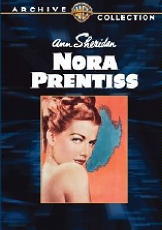
As you can see from the photo to the right, this previously hard-to-find film noir drama has recently been released on DVD as part of the Warner Brothers Archive Collection. Every fan of old movies should be buying these.
Even though they’re essentially print on demand items, the quality is good, and every one that’s purchased will convince the Powers That Be that there’s a small but steady market for them – I wouldn’t count on more – but continued income for Warners will convince Universal and MGM to step up their own programs of releasing old movies in their vaults on DVD.
And sometimes they go on sale, as this one was, and very well may still be, if you’re reading this early enough. It’s also one of the good ones, which you probably knew already before I came along to tell you about it.
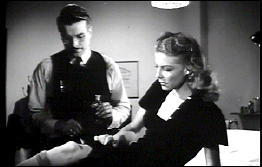
I don’t imagine that Ann Sheridan ever made a really bad movie, and if she did, I don’t want to know about it.
She’s the title character in this one, of course, a singer and night club entertainer who has a small traffic accident one evening, and the good Samaritan who comes to her rescue happens to be a doctor (Kent Smith) with a partner and a thriving practice who’s also a happily married man with two teen-aged children.
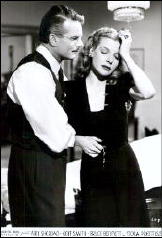
Well, maybe not so happily married. Doctor Talbot’s a mild-mannered creature of punctuality and habit, and his love life at home has gradually disappeared to less than nothing.
Some mild, good-natured flirting by Nora Prentiss during her first office visit does more than remind him of that, it shakes him up and down and back again.
She finds his reaction amusing at first, but more and more she finds herself taking his intentions seriously. We (the viewer) do not get to see the details of the burgeoning romance, but we certainly know what’s going on.
And if it were not for the prologue, in which we see a man in a jail cell, accused of Dr. Talbott’s murder, we would not know we are in a film noir movie at all, but since we do, we have a different perspective throughout the movie than even the characters themselves do, and into more and more difficulty do they certainly get — in true noir fashion all the way.
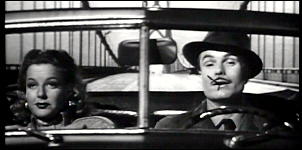
Ann Sheridan, she of the lovely face and body and low contralto voice, is obviously the star, but even though she is the “other woman” in this film, it is nearly innocently so. It is Kent Smith who undergoes the drastic twists of fate which this movie provides, in abundance, and on whose shoulders rests the burden of making the viewer feel as though it could actually happen.
I think he succeeds, but Kent Smith, a long-time but strictly second-tier movie and TV star and one you perhaps never heard of, lacks the charisma or sex appeal, to put it bluntly, to pull it off his role in this movie completely.
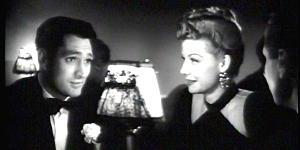
One wonders, at times, what a real life Nora Prentiss would see in an equally real life Dr. Talbot, best described as I said above as mild-mannered. Distinguished and accomplished, yes, but still rather weak and ineffectual.
Given that small quibble, plus a much more outrageous trial that takes place after the prologue is caught up to, in terms of chronological events, this is nonetheless a noir film that is very much worth watching.
If you have not seen it, and if you’ve read this far in the review, I very strongly recommend that you do.
Wed 28 Apr 2010
Posted by Steve under
Reviews[2] Comments
REVIEWED BY WALTER ALBERT:
LINDA BARNES – Lie Down With the Devil. St. Martin’s Minotaur, paperback, August 2009; hardcover edition, August 2008.
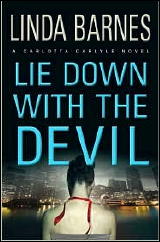
A couple of negative reviews I came across recently of a recent Linda Barnes Carlotta Carlyle novel made me wonder if I would find my generally favorable opinion of the series affected when I read Lie Down with the Devil. I must say that I didn’t and thought it one of the stronger outings in a while.
Carlotta’s personal life has always been a strong factor in the series, with her relationship with Sam Gianelli, the son of a Boston mobster family, and her little “sister,” Paolina, now a teenager with a troubled past, both complicating her none too stable professional life.
Sam has fled the country under threat of arrest for some serious crime he refuses to discuss with Carlotta, and Paolina, after the traumatic events of the previous novel Heart of the World, has been admitted to Mclean Hospital, a prestigious (and expensive) private facility where she is under treatment and continuous supervision, and refusing to speak with Carlotta.
Blocked from contact with both Sam and Paolina, Carlotta is persuaded by her tenant Roz to accept a case in which a young woman, soon to be married, is suspicious about her fiance’s activities, and wants him under surveillance to determine what he’s up to.
Sensing something off center about the explanation the young woman gives her, Carlotta still accepts the assignment, only to find, when the young woman is killed, the apparent victim of a random hit-and-run accident, that she’s been conned by the woman, and the case is linked to the Gianelli family in a way that will profoundly change her life.
Carlotta’s personal life may often take precedence over the investigations she undertakes, but her intelligence and dogged persistence in the face of daunting obstacles still make her one of the most richly conceived and intriguing protagonists in contemporary detective fiction.
Wed 28 Apr 2010
A 1001 MIDNIGHTS Review
by Bill Pronzini:
JON L. BREEN – The Gathering Place. Walker, hardcover, 1984; paperback, September 1986.
Well known for a number of years as a critic, short-story writer, and parodist, Jon L. Breen turned to the writing of novels in 1983 with Listen for the Click, an affectionate parody/pastiche of the classic country-house mystery.
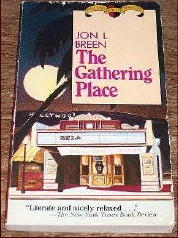
The Gathering Place, his second novel, is quite different — a bookshop mystery that combines the traditional fair-play whodunit with ghosts and other elements of the paranormal.
When Oscar Vermilion dies of heart failure, his used book store on Santa Monica Boulevard in Los Angeles, a fixture since 1935 and a gathering place for such literary lights as Nathaniel West and William Faulkner, is in danger of closing for good.
But Vermilion’s niece, Rachel Hennings, inherits the property, and she has both experience of her own in running a bookshop and a desire to maintain her uncle’s legacy.
That desire may not be easy to fulfill, however: Not long after her arrival from Arizona, Vermilion’s is broken into (although nothing is taken); ghostly manifestations begin to occur in the shop’s dusty confines (something guides her hand to write F. Scott Fitzgerald’s name in a copy of The Great Gatsby, a signature that turns out to be authentic); and she is presented with evidence that The Atlantis Courier, an early novel by leading Hollywood writer Arlen Kitchener, was actually ghostwritten by a man who was found murdered shortly after Oscar Vermilion’s death.
Breen neatly meshes these diverse elements, and a budding romance between Rachel and newspaperman Stu Wellman, into a suspenseful tale that keeps the reader guessing on several fronts.
Some may find the supernatural segments of the plot a strain on their credulity; this reviewer and general skeptic had no trouble with them, and in fact found that they add considerable depth and mystery to the story line. Another plus is the bookish lore and information the author weaves throughout the narrative.
One other recommended title by Jon Breen is Hair of the Sleuthhound (1982), a collection of some of the best of his short spoofs of distinguished crime writers and their works.
———
Reprinted with permission from 1001 Midnights, edited by Bill Pronzini & Marcia Muller and published by The Battered Silicon Dispatch Box, 2007. Copyright © 1986, 2007 by the Pronzini-Muller Family Trust.
Note: This book was previously reviewed on this blog by Marv Lachman.
Wed 28 Apr 2010
Posted by Steve under
Reviews[5] Comments
Reviewed by DAVID L. VINEYARD:
JENNIFER LEE CARRELL – Interred with Their Bones. Dutton, hardcover, September 2007. Plume, trade ppbk, August 2008. Published in the UK as The Shakespeare Secret, as by J. L. Carrell: Sphere, softcover, 2008.
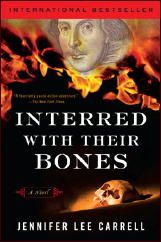
This is yet another in the category of what I call “Dollar Store Wonders,” exceptional books you find remaindered in the local Dollar Store.
Kate Stanley, the heroine, is a Shakespearean scholar and theatrical director currently putting on a production of Hamlet in the restored Globe Theater.
We are all haunted. Not by unexplained rappings or spectral auras, much less by headless horsemen and weeping queens — real ghosts pace the battlements of memory, endlessly whispering, Remember me.
One of those ghosts is Kate’s eccentric mentor Harvard professor Rosalind Howard, who shows up acting mysterious, and bearing a box she wants Kate to have. She has made a literary discovery that will rock the world.
“I’ve found something sweetheart, something big.”
But Kate is busy with the production of Hamlet, and has no time for Rosalind’s fancies, or her drama: “Tis in my memory locked, and you yourself shall keep the key of it.”
And Kate wishes she had been listening more closely when Rosalind is murdered and someone tries to burn down the Globe to cover it up, after an obvious, and fruitless search — fruitless because Kate had the box with her. And DCI Sinclair isn’t amused by either the crime or the drama surrounding it. The only person Kate can lean on his Sir Henry Lee, playing Hamlet’s father, a Thames River street brawler who grew up to be one of the lions of British theater.
The box yields a singularly uninvolving clue, a brooch, consisting of jeweled flowers, those found entwined in the dead Ophelia’s hair, and that quote of Rosalind’s was from one of Ophelia’s speeches.
The clue may be small, but the implications aren’t, and from such small things Kate is sent plunging into a mystery that goes back to Shakespeare’s time, and will set her on a quest across Europe.
The brooch leads to a rare Jacobean edition of Shakespeare’s Sonnets, only important if taken not as individual poetry, but as a single story, and from that the book of books in Shakespearean terms: the First Folio.
A book worth killing for, certainly. A torn page from one once sold in the hundred of thousands, but Rosalin was no mere book collector, and the mystery at the heart of Interred with Their Bones (the quote from Julius Caesar, not Hamlet by the way) is deeper and darker than the heart of any book collector.
The brooch is a clue that is key in solving the mystery at the heart of this book and literature’s oldest and most fought over mystery: Who was William Shakespeare?

Cutting across time while following Kate’s quest, Interred with Their Bones develops both an intriguing mystery and a taut and suspenseful tale as Kate’s investigation unfolds along side the historical sidelines, as the Folio leads to even great mysteries and more danger.
Carrell unfolds her tale with real suspense, excellent writing, and no little skill as Kate finds herself in Spain and learns the hard way that there are literary secrets worth killing for, and she is pitted against as duplicitous a pair of murderers as seen since Sam Spade sought a lead-coated bird.
Anyone vaguely familiar with the long-running debate over who actually wrote Shakespeare’s plays will doubly enjoy the book, but even if you never heard of Christopher Marlowe, Francis Bacon, or the Earl of Oxford you’ll enjoy this intriguing tale that manages a perfect balance of action, suspense, and revelations — the perfect literary thriller, with equal emphasis on both literary and thriller.
The solution may not be final: “The problem is it still doesn’t add up to much more than voices in the wind.” But Kate knows what she believes.
A scholarly and well written account of the various factions in the “who wrote Shakespeare” debate follows the novel and is worth reading on its own.
Kate Stanley has since returned in Haunt Me Still, another Shakespearean mystery where her production of Macbeth collides with Halloween and the meaning behind the ‘occult Shakespeare.’ Previously Carrell wrote the highly praised The Speckled Monster: A Tale of Battling Smallpox, a non-fiction work praised for its literate and novelistic content.
I don’t know how many books Carrell can get out of Shakespearean mysteries, but if she manages one from each of the plays, more power to her. I can’t wait to see what she does with the cannibalism and bloodbath of Titus Andronicus. A Dollar Store Wonder has now moved up to one of my favorite contemporary series, with a smart plucky and far from fainting heroine.
And to quote the book’s perfect last line:
“Here’s to a new story.”
Editorial Comment: While scouting on the Internet for some cover images to add to David’s review, I found that there is a third book in the series, The Shakespeare Curse. It’s already been published in England (as of last January), and it should be available here in the US soon.
[UPDATE] Later the same day. David’s right. See the first comment. The Shakespeare Curse is the UK title of Haunt Me Still, so at the present time there are still only two in the series. Nonetheless, by any standard you can think of, there are plenty of other plays for Carrell to choose from to use as a basis for for Number Three.
Tue 27 Apr 2010
Posted by Steve under
Reviews[6] Comments
IT IS PURELY MY OPINION
Reviews by L. J. Roberts
ALYS CLARE – Girl in a Red Tunic. Hodder & Stoughton, UK, hardcover, November 2005; softcover, August 2006.
Genre: Historical mystery. Series characters: Abbess Helewise/Josse d’Acquin, 8th in series. Setting: England-Middle Ages/1193.
First Sentence: He had to wait until it was dark and everyone was asleep.
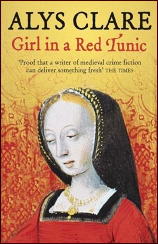
Abbess Helewise has been thinking about her life prior to joining the Abbey. She is surprised, yet concerned, when her son Loefgar, shows up with his wife, who looks pale and ill, and their 14-month son, who is unnaturally shy and won’t speak.
It is a relief to have her good friend, Josse d’Acquin, who had come to the Abbey ill but is recovered, on hand. When a man, who claims his brother was killed by Leofger in a dispute, is found hanged near the Abbey, Loefgar, and his family, disappear. Helewise fears for her son, and questions how events from the past are impact the present.
The most important element of a book, to me, is the characters. It has always been the characters which have drawn me to this series. We learn much more about Helewise than in previous books. These were times when an Abbess needn’t have been a nun, so it’s nice to see her as a woman, learn about her past, and how she came to Hawkenlye Abbey.
As always, we see the strength of the friendship between Helewise and Josse. Not only Helewise and Josse, but all the supporting characters come to life under Ms. Clare’s hand, even the ones you don’t trust. I do appreciate that we’ve see a transition in characters since the beginning of the series. People come and go in life ad Clare handles it in a way which works.
In most of the previous books, there has been a strong element of the metaphysical. I am one who, if done well, enjoys that. It is an element of this book as well, and it works. These were times when, even with the dominance of the Catholic Church, people, including the clergy, were highly superstitious and believed the ancient powers and abilities. Although it is quite clear that Ms. Clare is no fan of the Church, I would suspect any book set in this time, which did not include some reference to the metaphysical.
Which leads to the third thing: I love English history. Not only did Ms. Clare include a map and genealogical chart at the beginning of the book, she clearly does her period research. Early in the story, Clare talks about King Henry being captured for ransom and the impact the levies was having on the lives of the people.
She paints a vivid picture of people’s lives, including the hunger and cold due to lack of money. A slight misstep is in the plotting. I did figure out the motive and villain before the end, which reduced my rating, but it didn’t spoil the read for me.
In fact, I was so drawn into the book, I never wanted to put it down, and found the ending quite sad, but rather lovely. I look forward to continuing with this series.
Rating: Good Plus.
Editorial Comment: There are now 12 books in this “Hawkenlye” series, with the most recent appearing in 2008. Since then Alys Clare seems to have switched gears a bit, with two books in her “Aelf Fen” series being published in 2009. These novels are set in the reign of William II (1087-1100), with the series itself named after the imaginary area in which they take place.
Tue 27 Apr 2010
A 1001 MIDNIGHTS Review
by Bill Pronzini:
HERBERT BREAN – Wilders Walk Away. William Morrow & Co., hardcover, 1948. Hardcover reprint: Unicorn Mystery Book Club, 4-in-1 edition, June 1948. Reprint paperbacks include: Pocket #582, 1949; Collier, 1962; International Polygonics, 1988.
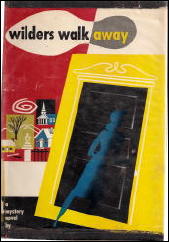
Free-lance magazine writer Reynold Frame comes to the Vermont village of Wilders Lane to do a series of articles on the colonial town and its history. The village’s founding family, the Wilders, are a decidedly curious bunch:
It is said that no Wilder ever died of old age; they just disappeared. In 1775 patriarch Jonathan Wilder walked down into the cellar of the family house and was never seen again. Another Wilder was a mate on the Mary Celeste. Still another vanished from a sandy beach in 1917, in full view of witnesses.
But Wilders “walking away” isn’t a phenomenon relegated to past history, as Frame soon learns. First young Ellen Wilder and then Aunt Mary also vanish from watched rooms inside the house, while he himself is on the premises.
There is plenty of eerie mystery here, a fine sense of small-town New England life circa 1948, and some fascinating bits and pieces of colonial history woven in. Plus a Revolutionary War treasure, secret passages and hidden rooms, an array of offbeat characters, and of course a love interest for Frame (Constance, one of the few Wilders who does not walk away).
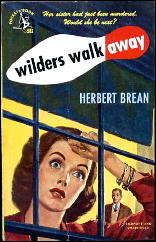
The solutions to the “impossible” occurrences are well set up, if not particularly ingenious — the trickiest is the sandy-beach disappearance — but that doesn’t spoil the book’s appeal.
Reynold Frame appears in three other novels — The Darker the Night (1949), Hardly a Man Is Now Alive (1950), and The Clock Strikes Thirteen (1952) — all of which likewise make good use of unusual settings, strange doings, and past crimes.
Brean also created another journalist detective, William Deacon, for The Traces of Brillhart (1960) and The Traces of Merilee (1966).
———
Reprinted with permission from 1001 Midnights, edited by Bill Pronzini & Marcia Muller and published by The Battered Silicon Dispatch Box, 2007. Copyright © 1986, 2007 by the Pronzini-Muller Family Trust.
Editorial Comment: This title is one of those compiled in John Pugmire’s profusely illustrated article “A Locked Room Library,” to be found here on the main Mystery*File website. (Follow the link.)
Next Page »








